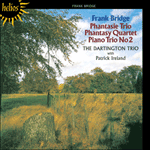
Welcome to Hyperion Records, an independent British classical label devoted to presenting high-quality recordings of music of all styles and from all periods from the twelfth century to the twenty-first.
Hyperion offers both CDs, and downloads in a number of formats. The site is also available in several languages.
Please use the dropdown buttons to set your preferred options, or use the checkbox to accept the defaults.

| The Dartington Piano Trio, Patrick Ireland (viola)» More |
From his earliest student efforts, Bridge had employed cyclic forms in his chamber music, ensuring that his main themes and melodies enjoyed a close family likeness across each movement. In his Cobbett Phantasies he went a step further, refining an ‘arch form’ in which all the musical ideas derived from a single source. In this way he was able to replace the conventional development section of the classical sonata form, in which he had been trained under Stanford, with contrasting but related episodes—mirroring the slow movement and scherzo elements one would find in a larger multi-movement chamber work. This Cobbett-inspired approach to constructing single movements and complete works stayed with Bridge throughout his career, reaching its most expansive form in the cello concerto Oration.
While the three early Phantasies are uncomplicated in their design, the Phantasy Piano Quartet, completed in June 1910, is the most effective, revealing Bridge’s early style at its most fluent. Writing in the 1948 Aldeburgh Festival programme book, Benjamin Britten revealed the essence of this work perfectly: ‘Sonorous yet lucid, with clear, clean lines, grateful to listen to and to play. It is the music of a practical musician, brought up in German orthodoxy, but who loved French romanticism and conception of sound—Brahms happily tempered with Fauré.’ All the musical ideas spring from the passionate opening flourish. The first section (Andante con moto) flows with Gallic grace, rather like a Barcarolle. There follows a fleet-footed scherzo (Allegro vivace), with a contrasting song-like trio section that looks back to the opening ideas. A short recitative-like passage then leads seamlessly back to the reprise, which opens out into an impassioned climax before dying away to what Britten describes as ‘a short coda which suggests the deep red afterglow of a sunset’.
from notes by Paul Hindmarsh © 2013
 Bridge: Piano Trios & Phantasy Quartet Bridge: Piano Trios & Phantasy Quartet‘These mellifluous and enjoyable works reveal [Bridge] as, of all British composers of his time, the nearest to Fauré in his aesthetic. Hyperion's re ... ‘The performances catch the subtly shifting moods … and the recordings sound as atmospheric and sensitively balanced as when they first appeared, ...» More |

